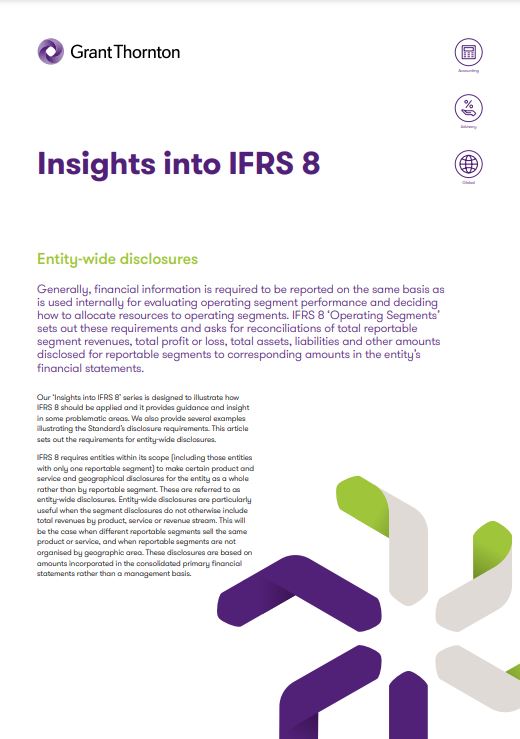IFRS 8 requires entities within its scope (including those entities with only one reportable segment) to make certain product and service and geographical disclosures for the entity as a whole rather than by reportable segment. These are referred to as entity-wide disclosures. Entity-wide disclosures are particularly useful when the segment disclosures do not otherwise include total revenues by product, service or revenue stream. This will be the case when different reportable segments sell the same product or service, and when reportable segments are not organised by geographic area. These disclosures are based on amounts incorporated in the consolidated primary financial statements rather than a management basis.
Exemptions from entity-wide disclosures
Before looking at the disclosures required in more detail, it is worth noting separate disclosure is not required if the information is otherwise provided as part of the reportable segment information.
Additionally, the entity-wide disclosures are not required where the necessary information is not available and the cost to develop it would be excessive. However, because the information is on an entity basis, it is not expected this exemption will be invoked often. Most entities are likely to collect and retain information about their geographical operations and products and services. If the exemption is taken, that fact must be disclosed.
Information about products and services
In addition to revenue-related disclosures required by other standards such as IFRS 15 ‘Revenue from Contracts with Customers’, IFRS 8 requires entities to disclose the revenues from external customers for each product and service or each group of similar products and services. Revenues disclosed should be based on the financial information used to produce the entity’s financial statements.
Information about geographical areas
Entities disclose the following geographical information, based on financial information used to produce the entity’s financial statements:
- Revenues from external customers attributed to:
- the entity’s country of domicile, and
- all foreign countries in total from which the entity derives revenues.
- The basis for attributing revenue from external customers to individual countries (see below).
- Non-current assets (see below), other than financial instruments, deferred tax assets, post employment benefit assets and rights arising under insurance contracts located in:
- the entity’s country of domicile
- all other foreign countries in total in which the entity holds assets.
- If revenues attributable to and/or assets located in an individual foreign country are material those revenues and/or assets should be separately disclosed.
Sub-totals may be given on a voluntary basis for groups of countries.
Basis for attributing revenues to countries
IFRS 8 is not specific as to how revenues are attributed to individual countries, but does require disclosure of the basis for this attribution. Commonly used approaches include using the location of the customer or the country where the sale occurred but may be on any other reasonable basis.
Non-current assets
Non-current assets (as classified in accordance with IAS 1 ‘Presentation of Financial Statements’) identified for the purpose of IFRS 8 disclosure include tangible and intangible assets, but exclude financial instruments, deferred tax assets, post-employment benefit assets and rights arising under insurance contracts. Where an entity classifies assets in its statement of financial position using a liquidity presentation, non-current assets are assets that include amounts expected to be recovered more than 12 months after the reporting date.
IFRS 8 requires disclosure of an entity’s reliance on its major customers. If revenues from transactions with a single external customer amount to 10% or more of an entity’s revenues, the entity should disclose:
- that fact
- the total amount of revenues from each such customer, and
- the identity of the segment or segments that report the revenues.
There is no need to disclose the amount of revenues that each segment reports from that customer or customers or the identity of the customer(s).
For the purpose of this disclosure, a group of entities known by the reporting entity to be under common control should be considered to be a single customer.


